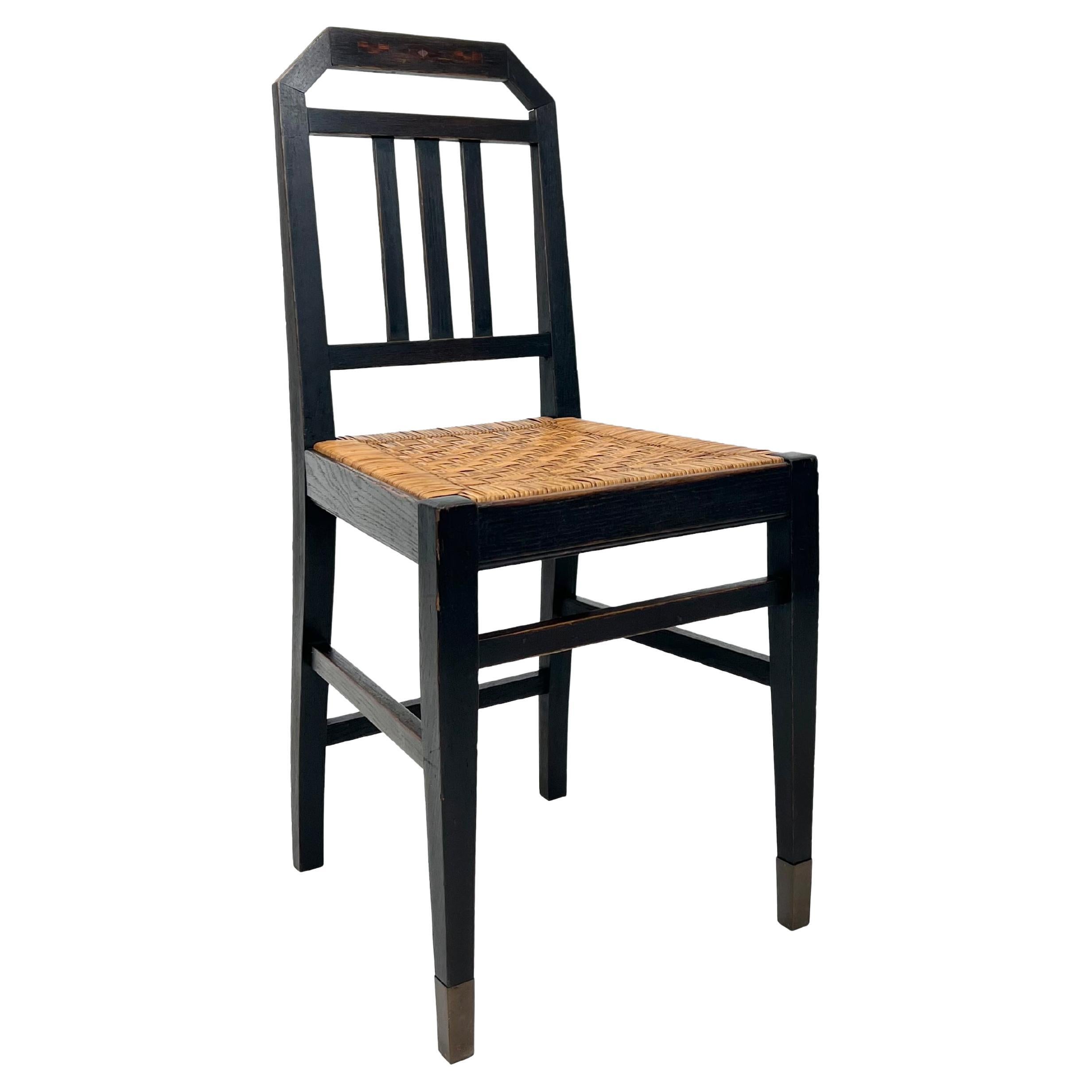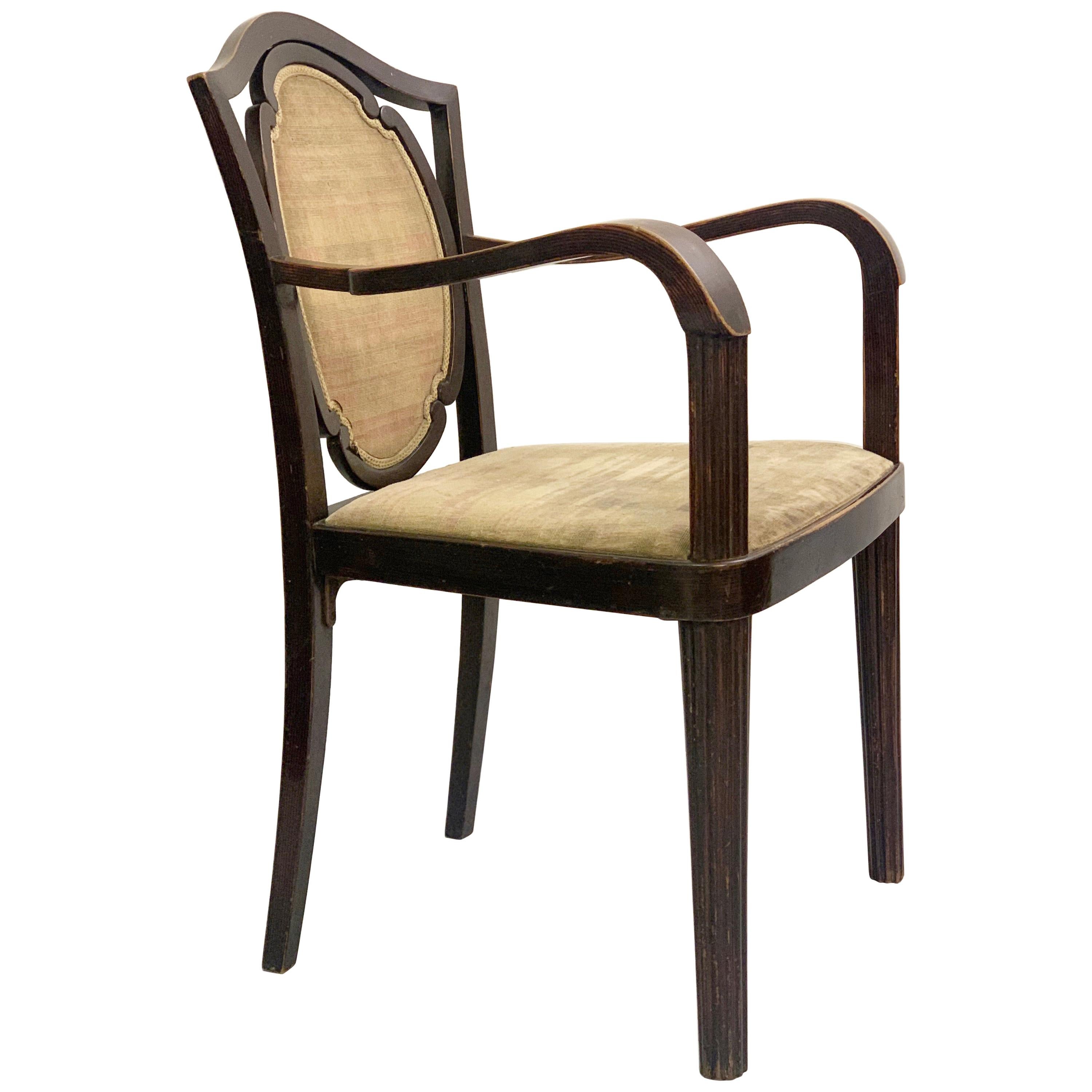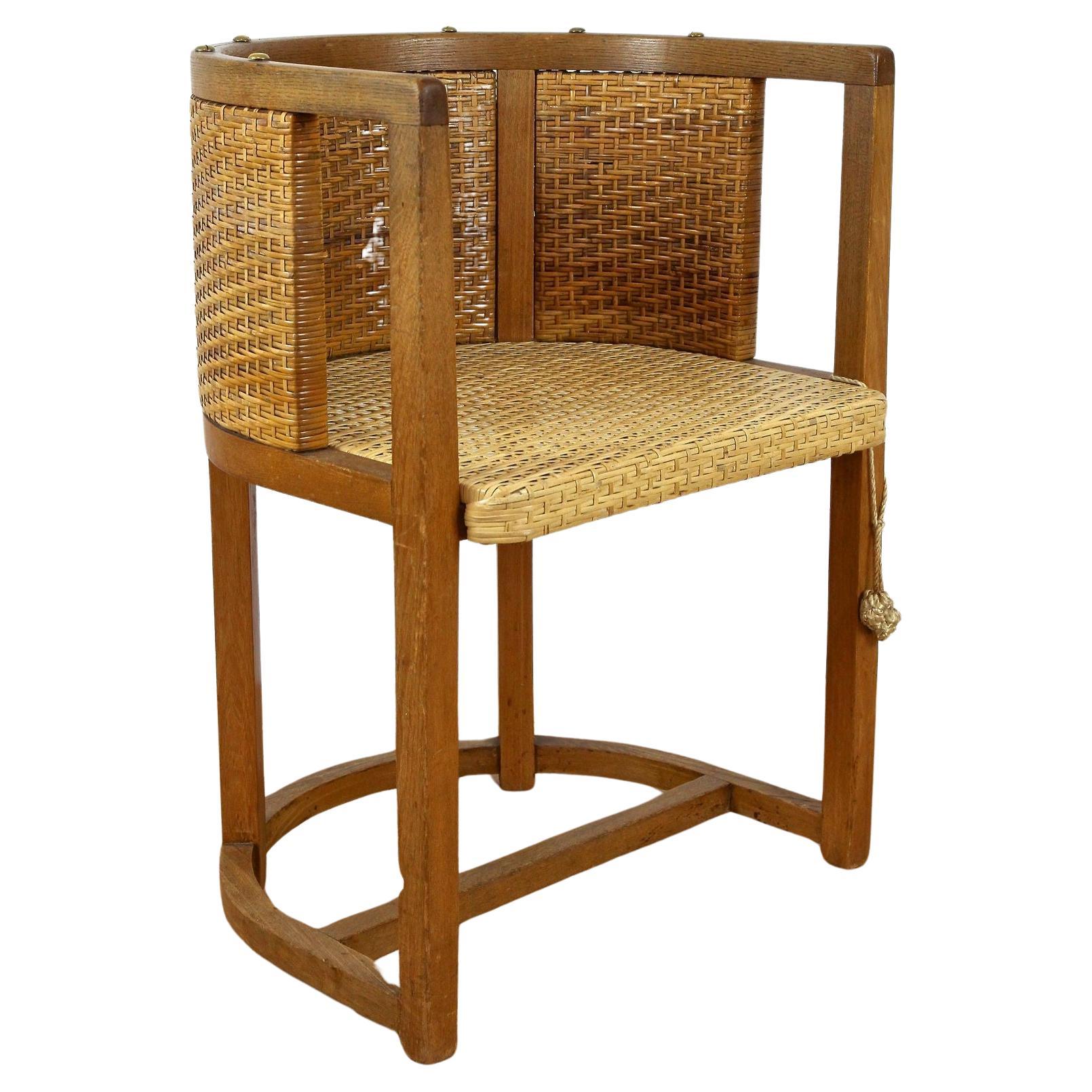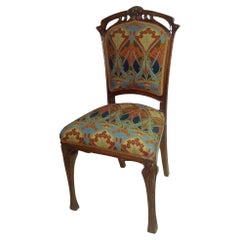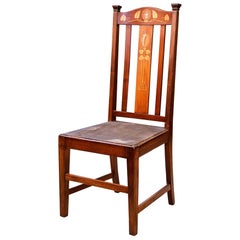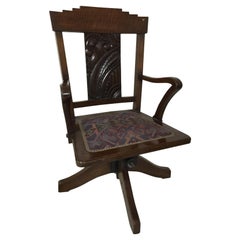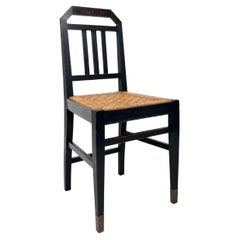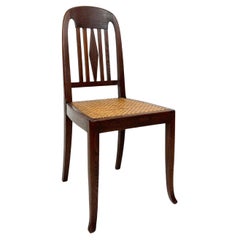Items Similar to Child seat ( Attributed Wilhelm Schmidt For Prag- Rudniker ) 1887, Prague
Video Loading
Want more images or videos?
Request additional images or videos from the seller
1 of 12
Child seat ( Attributed Wilhelm Schmidt For Prag- Rudniker ) 1887, Prague
$9,500
£7,178.84
€8,289.80
CA$13,274.82
A$14,729.53
CHF 7,715.64
MX$180,623.54
NOK 98,140.32
SEK 92,640.28
DKK 61,822.20
Shipping
Retrieving quote...The 1stDibs Promise:
Authenticity Guarantee,
Money-Back Guarantee,
24-Hour Cancellation
About the Item
Chair Jugendstil, Art Nouveau, Liberty
Material: Wood
Country:France
We have specialized in the sale of Art Deco and Art Nouveau and Vintage styles since 1982.If you have any questions we are at your disposal.
Pushing the button that reads 'View All From Seller'. And you can see more objects to the style for sale.
rag-Rudniker Korbwaren-Fabrication (Basketwork Factory)
The „Prag-Rudniker Korbwaren-Fabrication” had its origins in 1877 in Rudnik (Galicia), where Ferdinand Ernst Count Hompesch established a wickerwork school. Distribution of the products was done by the Prague merchants Karl and Josef Kraus. Eventually, Karl and Josef Kraus founded Prag-Rudniker Korbwaren-Fabrication, registered in the trade register in 1886. The head office was located in Prague and was moved to Vienna in 1910, where a branch office had existed in Mariahilfer Straße from the outset.
Prag-Rudniker quickly developed into a major trading company that boasted to be the “largest wickerwork company of the continent”. The company had about 2,500 employees, with factories in Budapest, Prague, Rudnik and Vienna and additional branch offices in Germany, France, England, the Middle East and the United States, thus being represented worldwide.
Why are there so many antiques in Argentina?
In the 1880 – 1940 there was a grate wave of immigration encouraged by the periods of war that were taking place.
1st World War took place between 1914 and 1918
2nd World War took place between 1939 and 1945
The immigrants options were New York or Buenos Aires. Tickets were cheap and in Buenos Aires they were welcomed with open arms, as it was a country where everything was still to be done.
Argentina was the country of new opportunities, labour was needed and religious freedom was assured, in many cases the of the family travel first until they were settled and then the rest of the family members join them.
In the immigrant museum “Ellis Island Immigrant Building” in New York you can se the promotional posters of the boats that would take them to a new life.
Between the years 1895 and 1896, Argentina had the highest DGP (gross domestic product) per capita in the world according to the Maddison Historical Statistics index, this situation arose due to the large amount of food being exported to European countries, which were at war.
The Argentinean ships left the port of Buenos Aires with food, but they returned with furniture, clothes and construction elements, (it´s common to see this the old buildings of the historic neighbourhood of San Telmo, the beams with the inscription “Made in England)”, as well as many markets that were built in Buenos Aires, such us the San Telmo Market, whose structure was brought by ship and afterwards assembled in 900 Defensa Street.
With the great influence of European immigrants living in the country, the children of the upper classes travelled to study in France, resulting in the inauguration of “La Maison Argentinienne”, on 27th of June 1928, in the international city of Paris, which hosted many Argentinians that were studying in Frace.
It´s the fourth house to be built after France, Canada and Belgium, being the first Spanish-speaking one. Still in place today (17 Bd Jourdan, 75014, Paris, France). Many of the children of these wealthy families who attended international art exhibitions, museums and art courses abroad, took a keen interest in the European style. This is why Buenos Aires was at the time referred as “The Paris of South America”.
Between the years 1890 and 1920 more than a hundred Palaces were built on Alvear Avenue the most exclusive avenue in Buenos Aires. Today some of these palaces have been transformed into museums, hotels and embassies.
In the year 1936, the Kavanagh building was inaugurated, it was the tallest reinforced concrete building in South America.
During 1994 the American Society of Civil Engineers distinguished it as an “international engineering milestone”, and it´s now considered a World Heritage of Modern Architecture.
At the time was common to hire foreign architects such as Le Corbusier, who visited Buenos Aires/Argentina in 1929 and in 1948 he drew up the blueprints for a house built in La Plata City (which was declared a World Heritage Site).
In 1947, the Hungarian architect Marcelo Breuer designed “Parador Ariston” in the seaside city of Mar del Plata. After an Argentinean student at Harvard University convinced him to come to Argentina. He worked on an urban development project in the Casa Amarilla, area of La Boca.
The Ukrainian architect, Vladimiro Acosta, arrives in Argentina in 1928 and worked as an architect until que moved to Brazil.
Antonio Bonet, a Spanish architect who worked with Le Corbusier in Paris, arrives in Argentina in 1937, where he carried out several architectural works and in 1938 designs the well-known BFK chair.
Andres Kálnay, of Hungarian origin, made around 120 architectural masterpieces, among which the former Munich brewery stands out, he even made the furniture’s design.
The German architect, Walter Gropius, director of the Bauhaus, lived in Argentina, where he wrote articles for “Sur” magazine and founded in Buenos Aires, an architectural firm with Franz Möller, who was also an architect, where he built two houses.
At the same time several famous designers decided to immigrate to Argentina, among them we can find the well-known French designer, Jean-Michel Frank, who arrived in the country in 1940 and also worked for the Rockefeller family.
Special pieces were made, which were sold exclusively in the country, such as the well-known German company “WMF”, who sold their products by catalogue, which were chosen by the ladies of high society in the list of wedding gifts, as well as the pieces designed by Christofle.
The Swiss sculptor Alberto Giacometti, made special pieces for Argentinean mansions.
In 1904 the first Jansen branch outside Paris was established in Buenos Aires, as the Argentinean clientele demanded a large amount of furniture, from the end of the 19th century to the mid-20th century.
In 1970, the brand Rigolleau Argentina made pieces authorised by Lalique.
The brands Maple and Thompson also set up shop in the country.
The French plastic artist, Marcel Duchamp moved to Argentina in 1918-1919.
Glass signed Gallé, Charder, Leverre, Schneider, Muller and other French firms. They were bought in flower shops and were given to ladies with beautiful floral arrangements.
Some furniture manufacturers travelled to international fairs and bough the patterns to produce the furniture in Argentina, such as the furniture firm Englander and Bonta, who bought the patterns ins Italy.
It is worth mentioning that in Argentina we have the largest community of Italians outside of Italy, as it is estimated that 70 percent of the inhabitants have at least one Italian descendant, followed by Spanish immigrants.
The most Important furniture stores in Argentina:
Comte is founded in 1934 (under the direct management of Jean Michel Frank in 1940).
Nordiska (Swedish company established in 1934).
Churba in 1960, a company that brought foreign designers to present their furniture in the country:
Denmark: (Arne Jacobsen, Finn Juhl, Bender Madsen, Ejner Larsen, Poul Kjaerholm, Hans Wegner)
Sweden: (Hans Agne Jakobsson, Gustavsberg)
United States: (Herman Miller)
Finland: (Lisa Johansson, Folke Arstrom, Tapio Wirkkala, Alvar Aalto, Timo Sarpaneva)
Swedish Factory: (Orrefors)
Italy: (Littala, Vico Magistretti, Emma Gismondi, Gae Aulenti, Angelo Mangiarotti, Elio Martinelli, Gianna Celada, Angelo Mangiarotti, Mario Bellini, Carlo Scarpa)
Finland: (Olivia Toikka)
Plata Lappas (Lappas Silver): a goldsmith shop founded in 1887 in Argentina by Alcibiades Lappas of Greek origin.
In 2019, in Argentina took place “the Art Deco world congress”, in which we participated as hosts invited by Geo Darder, founder of the Copperbridge – Foundation, in which prominent people from all over the world attended to learn about Art Deco in Argentina.
Argentina currently has more than 100 Art Deco buildings and another 90 Art Nouveau buildings throughout the city of Buenos Aires.
Argentina is a country that has not been involved in many wars, which is why it has been a refuge for works of art and antiques from different periods of time, unlike European countries. That is way many collectors, museums and antique dealers from all over the world visit it, you should not miss the opportunity to visit this great country.
Laura Guevara Kjuder, architect.
- Dimensions:Height: 30.71 in (78 cm)Width: 16.15 in (41 cm)Depth: 15.75 in (40 cm)
- Style:Art Nouveau (Of the Period)
- Materials and Techniques:
- Place of Origin:
- Period:
- Date of Manufacture:1887
- Condition:Wear consistent with age and use.
- Seller Location:Ciudad Autónoma Buenos Aires, AR
- Reference Number:Seller: F-AC-041stDibs: LU6785230746782
About the Seller
5.0
Vetted Professional Seller
Every seller passes strict standards for authenticity and reliability
Established in 1982
1stDibs seller since 2022
37 sales on 1stDibs
Typical response time: <1 hour
- ShippingRetrieving quote...Shipping from: Ciudad Autónoma Buenos Aires, Argentina
- Return Policy
Authenticity Guarantee
In the unlikely event there’s an issue with an item’s authenticity, contact us within 1 year for a full refund. DetailsMoney-Back Guarantee
If your item is not as described, is damaged in transit, or does not arrive, contact us within 7 days for a full refund. Details24-Hour Cancellation
You have a 24-hour grace period in which to reconsider your purchase, with no questions asked.Vetted Professional Sellers
Our world-class sellers must adhere to strict standards for service and quality, maintaining the integrity of our listings.Price-Match Guarantee
If you find that a seller listed the same item for a lower price elsewhere, we’ll match it.Trusted Global Delivery
Our best-in-class carrier network provides specialized shipping options worldwide, including custom delivery.More From This Seller
View AllJugendstil, Art Nouveau, Liberty Chair, 1900, France
Located in Ciudad Autónoma Buenos Aires, C
Chair Jugendstil, Art Nouveau, Liberty
Material: Wood
Country:France
We have specialized in the sale of Art Deco and Art Nouveau and Vintage styles since 1982.If you have any questi...
Category
Antique Early 1900s French Art Nouveau Chairs
Materials
Wood
Chair Year :1865, Attributed to Shapland and Petter of Barnstaple, English
By Shapland & Petter
Located in Ciudad Autónoma Buenos Aires, C
Chair
Year 1865
Country: England
We have specialized in the sale of Art Deco and Art Nouveau and Vintage styles since 1982. If you have any questions we are at your disposal.
Pushing...
Category
Antique 1860s English Arts and Crafts Chairs
Materials
Wood
Desk Chair in Leather and Wood, Style: Art Deco, France, 1930
Located in Ciudad Autónoma Buenos Aires, C
Art Deco Armchair
Wood and leather
Year: 1930
Country: France
If you are looking for a desk chair to match your desk, we have what you need.
We have specialized in the sale of Art ...
Category
Vintage 1930s French Art Deco Office Chairs and Desk Chairs
Materials
Wood, Leather
Desk Chair Style: Art Deco, France, 1930
Located in Ciudad Autónoma Buenos Aires, C
Art Deco desk chair
Wood
Year: 1930
Country: France
If you are looking for a desk chair to match your desk, we have what you need.
We have specialized in the sale of Art Deco and Art Nouveau and Vintage styles since 1982.
Pushing the button that reads 'View All From Seller'. And you can see more objects to the style for sale.
Why are there so many antiques in Argentina?
In the 1880 – 1940 there was a grate wave of immigration encouraged by the periods of war that were taking place.
1st World War took place between 1914 and 1918
2nd World War took place between 1939 and 1945
The immigrants options were New York or Buenos Aires. Tickets were cheap and in Buenos Aires they were welcomed with open arms, as it was a country where everything was still to be done.
Argentina was the country of new opportunities, labour was needed and religious freedom was assured, in many cases the of the family travel first until they were settled and then the rest of the family members join them.
In the immigrant museum “Ellis Island Immigrant Building” in New York you can se the promotional posters of the boats that would take them to a new life.
Between the years 1895 and 1896, Argentina had the highest DGP (gross domestic product) per capita in the world according to the Maddison Historical Statistics index, this situation arose due to the large amount of food being exported to European countries, which were at war.
The Argentinean ships left the port of Buenos Aires with food, but they returned with furniture, clothes and construction elements, (it´s common to see this the old buildings of the historic neighbourhood of San Telmo, the beams with the inscription “Made in England)”, as well as many markets that were built in Buenos Aires, such us the San Telmo Market, whose structure was brought by ship and afterwards assembled in 900 Defensa Street.
With the great influence of European immigrants living in the country, the children of the upper classes travelled to study in France, resulting in the inauguration of “La Maison Argentinienne”, on 27th of June 1928, in the international city of Paris, which hosted many Argentinians that were studying in Frace.
It´s the fourth house to be built after France, Canada and Belgium, being the first Spanish-speaking one. Still in place today (17 Bd Jourdan, 75014, Paris, France). Many of the children of these wealthy families who attended international art exhibitions, museums and art courses abroad, took a keen interest in the European style. This is why Buenos Aires was at the time referred as “The Paris of South America”.
Between the years 1890 and 1920 more than a hundred Palaces were built on Alvear Avenue the most exclusive avenue in Buenos Aires. Today some of these palaces have been transformed into museums, hotels and embassies.
In the year 1936, the Kavanagh building was inaugurated, it was the tallest reinforced concrete building in South America.
During 1994 the American Society of Civil Engineers distinguished it as an “international engineering milestone”, and it´s now considered a World Heritage of Modern Architecture.
At the time was common to hire foreign architects such as Le Corbusier, who visited Buenos Aires/Argentina in 1929 and in 1948 he drew up the blueprints for a house built in La Plata City (which was declared a World Heritage Site).
In 1947, the Hungarian architect Marcelo Breuer designed “Parador Ariston” in the seaside city of Mar del Plata. After an Argentinean student at Harvard University convinced him to come to Argentina. He worked on an urban development project in the Casa Amarilla, area of La Boca.
The Ukrainian architect, Vladimiro Acosta, arrives in Argentina in 1928 and worked as an architect until que moved to Brazil.
Antonio Bonet, a Spanish architect who worked with Le Corbusier in Paris, arrives in Argentina in 1937, where he carried out several architectural works and in 1938 designs the well-known BFK chair...
Category
Vintage 1930s French Art Deco Office Chairs and Desk Chairs
Materials
Wood
Desk Chair for the King, Style: Art Deco, 1930, German
Located in Ciudad Autónoma Buenos Aires, C
Art Deco desk chair
Material: leather and wood
Year: 1930
Country: Germany
If you are looking for a desk chair to match your desk, we have what you ne...
Category
Vintage 1930s German Art Deco Armchairs
Materials
Leather, Wood
Desk Chair Style: Art Deco, France, 1920
Located in Ciudad Autónoma Buenos Aires, C
Art Deco desk chair
Country: France
If you are looking for a desk chair to match your desk, we have what you need.
We have specialized in the sale of Art Deco and Art Nouveau and Vintage styles since 1982. If you have any questions we are at your disposal.
Pushing the button that reads 'View All From Seller'. And you can see more objects to the style for sale.
Why are there so many antiques in Argentina?
In the 1880 – 1940 there was a grate wave of immigration encouraged by the periods of war that were taking place.
1st World War took place between 1914 and 1918
2nd World War took place between 1939 and 1945
The immigrants options were New York or Buenos Aires. Tickets were cheap and in Buenos Aires they were welcomed with open arms, as it was a country where everything was still to be done.
Argentina was the country of new opportunities, labour was needed and religious freedom was assured, in many cases the of the family travel first until they were settled and then the rest of the family members join them.
In the immigrant museum “Ellis Island Immigrant Building” in New York you can se the promotional posters of the boats that would take them to a new life.
Between the years 1895 and 1896, Argentina had the highest DGP (gross domestic product) per capita in the world according to the Maddison Historical Statistics index, this situation arose due to the large amount of food being exported to European countries, which were at war.
The Argentinean ships left the port of Buenos Aires with food, but they returned with furniture, clothes and construction elements, (it´s common to see this the old buildings of the historic neighbourhood of San Telmo, the beams with the inscription “Made in England)”, as well as many markets that were built in Buenos Aires, such us the San Telmo Market, whose structure was brought by ship and afterwards assembled in 900 Defensa Street.
With the great influence of European immigrants living in the country, the children of the upper classes travelled to study in France, resulting in the inauguration of “La Maison Argentinienne”, on 27th of June 1928, in the international city of Paris, which hosted many Argentinians that were studying in Frace.
It´s the fourth house to be built after France, Canada and Belgium, being the first Spanish-speaking one. Still in place today (17 Bd Jourdan, 75014, Paris, France). Many of the children of these wealthy families who attended international art exhibitions, museums and art courses abroad, took a keen interest in the European style. This is why Buenos Aires was at the time referred as “The Paris of South America”.
Between the years 1890 and 1920 more than a hundred Palaces were built on Alvear Avenue the most exclusive avenue in Buenos Aires. Today some of these palaces have been transformed into museums, hotels and embassies.
In the year 1936, the Kavanagh building was inaugurated, it was the tallest reinforced concrete building in South America.
During 1994 the American Society of Civil Engineers distinguished it as an “international engineering milestone”, and it´s now considered a World Heritage of Modern Architecture.
At the time was common to hire foreign architects such as Le Corbusier, who visited Buenos Aires/Argentina in 1929 and in 1948 he drew up the blueprints for a house built in La Plata City (which was declared a World Heritage Site).
In 1947, the Hungarian architect Marcelo Breuer designed “Parador Ariston” in the seaside city of Mar del Plata. After an Argentinean student at Harvard University convinced him to come to Argentina. He worked on an urban development project in the Casa Amarilla, area of La Boca.
The Ukrainian architect, Vladimiro Acosta, arrives in Argentina in 1928 and worked as an architect until que moved to Brazil.
Antonio Bonet, a Spanish architect who worked with Le Corbusier in Paris, arrives in Argentina in 1937, where he carried out several architectural works and in 1938 designs the well-known BFK...
Category
Vintage 1920s French Art Deco Office Chairs and Desk Chairs
Materials
Wood
You May Also Like
Jugendstil Chair in the Style of Vienna Secession, 1900s
Located in Reichenschwand, DE
This early 20th-century Jugendstil chair reflects the refined minimalism and geometric precision associated with the Vienna Secession movement. Its form is sharply defined, favoring ...
Category
Antique Early 1900s German Jugendstil Chairs
Materials
Metal
Art Nouveau Armchair by Otto Prutscher, Austria
By Otto Prutscher
Located in Brussels, BE
Art Nouveau armchair by Otto Prutscher, Austria.
Category
Antique Early 1900s Austrian Armchairs
Materials
Wood
German Jugendstil Chair in the Style of Bruno Paul, around 1905
By Bruno Paul
Located in Reichenschwand, DE
This slender Jugendstil chair, dating from around 1905, reflects the refined design language of the early 20th century with elegant restraint. Its form echoes the work of German arch...
Category
Antique Early 1900s German Jugendstil Chairs
Materials
Rattan, Oak
Children's Art Nouveau Armchair by J&J Kohn
By Jacob & Josef Kohn
Located in Banská Štiavnica, SK
Children's Art Nouveau Armchair with original rattan seat by J&J Kohn in original condition.
Category
Antique Early 1900s Austrian Jugendstil Children's Furniture
Materials
Rattan, Beech, Bentwood
Oak Armchair, Art Nouveau, probably Vienna, Early 20th Century
Located in Greding, DE
Art Nouveau armchair crafted from oak, featuring gently curved armrests that sweep forward in a fluid motion. The subtly rising cross-stretchers lend the piece a refined, architectur...
Category
Early 20th Century Austrian Vienna Secession Armchairs
Materials
Fabric, Oak
20th Century Art Nouveau Elmwood Armchair 1307 by Prag-Rudniker, AT ca. 1903
By Wilhelm Schmidt, Prag-Rudniker Korbwaren-Fabrication
Located in Lichtenberg, AT
Another design icon in our "rare chair" collection is this fantastic Vienesse secession armchair - Mod. 1307 (first edition!) designed by Wilhelm Sc...
Category
Early 20th Century Austrian Art Nouveau Armchairs
Materials
Rattan, Elm
More Ways To Browse
Herman Miller Time Life Chair
Harvard Chair
Lalique Chair
Ladies Antique Chair
Liberty Chair England
Used School Furniture Canada
Mid Century German School Chairs
The Wicker Works
Antique Wicker Chair
Antique Wicker Furniture Chairs
Large Wicker Chair
Childs High Chair
French Child Chair
Hans Wegner Two Seater
Antique Vintage Wicker Furniture
Spanish Wicker Chairs
Josef Urban
Childrens Wicker Chair
